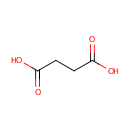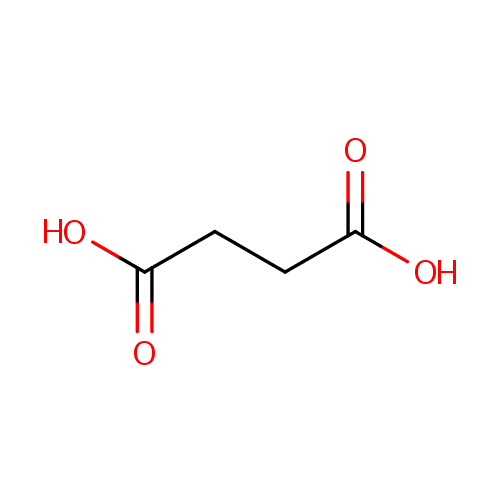
Succinic acid (PAMDB000107)
| Record Information | ||||||||||||||||||||||||||||||||||||||||||||||||||||||||||
|---|---|---|---|---|---|---|---|---|---|---|---|---|---|---|---|---|---|---|---|---|---|---|---|---|---|---|---|---|---|---|---|---|---|---|---|---|---|---|---|---|---|---|---|---|---|---|---|---|---|---|---|---|---|---|---|---|---|---|
| Version | 1.0 | |||||||||||||||||||||||||||||||||||||||||||||||||||||||||
| Update Date | 1/22/2018 11:54:54 AM | |||||||||||||||||||||||||||||||||||||||||||||||||||||||||
| Metabolite ID | PAMDB000107 | |||||||||||||||||||||||||||||||||||||||||||||||||||||||||
| Identification | ||||||||||||||||||||||||||||||||||||||||||||||||||||||||||
| Name: | Succinic acid | |||||||||||||||||||||||||||||||||||||||||||||||||||||||||
| Description: | Succinic acid is a dicarboxylic acid. The anion, succinate, is a component of the citric acid cycle capable of donating electrons to the electron transfer chain. SDH with a covalently attached FAD prosthetic group, binds enzyme substrates (succinate and fumarate) and physiological regulators (oxaloacetate and ATP). Oxidizing succinate links SDH to the fast-cycling Krebs cycle portion where it participates in the breakdown of acetyl-CoA throughout the whole Krebs cycle. | |||||||||||||||||||||||||||||||||||||||||||||||||||||||||
| Structure | ||||||||||||||||||||||||||||||||||||||||||||||||||||||||||
| Synonyms: |
| |||||||||||||||||||||||||||||||||||||||||||||||||||||||||
| Chemical Formula: | C4H6O4 | |||||||||||||||||||||||||||||||||||||||||||||||||||||||||
| Average Molecular Weight: | 118.088 | |||||||||||||||||||||||||||||||||||||||||||||||||||||||||
| Monoisotopic Molecular Weight: | 118.02660868 | |||||||||||||||||||||||||||||||||||||||||||||||||||||||||
| InChI Key: | KDYFGRWQOYBRFD-UHFFFAOYSA-N | |||||||||||||||||||||||||||||||||||||||||||||||||||||||||
| InChI: | InChI=1S/C4H6O4/c5-3(6)1-2-4(7)8/h1-2H2,(H,5,6)(H,7,8) | |||||||||||||||||||||||||||||||||||||||||||||||||||||||||
| CAS number: | 110-15-6 | |||||||||||||||||||||||||||||||||||||||||||||||||||||||||
| IUPAC Name: | butanedioic acid | |||||||||||||||||||||||||||||||||||||||||||||||||||||||||
| Traditional IUPAC Name: | succinic acid | |||||||||||||||||||||||||||||||||||||||||||||||||||||||||
| SMILES: | OC(=O)CCC(O)=O | |||||||||||||||||||||||||||||||||||||||||||||||||||||||||
| Chemical Taxonomy | ||||||||||||||||||||||||||||||||||||||||||||||||||||||||||
| Taxonomy Description | This compound belongs to the class of organic compounds known as dicarboxylic acids and derivatives. These are organic compounds containing exactly two carboxylic acid groups. | |||||||||||||||||||||||||||||||||||||||||||||||||||||||||
| Kingdom | Organic compounds | |||||||||||||||||||||||||||||||||||||||||||||||||||||||||
| Super Class | Organic acids and derivatives | |||||||||||||||||||||||||||||||||||||||||||||||||||||||||
| Class | Carboxylic acids and derivatives | |||||||||||||||||||||||||||||||||||||||||||||||||||||||||
| Sub Class | Dicarboxylic acids and derivatives | |||||||||||||||||||||||||||||||||||||||||||||||||||||||||
| Direct Parent | Dicarboxylic acids and derivatives | |||||||||||||||||||||||||||||||||||||||||||||||||||||||||
| Alternative Parents | ||||||||||||||||||||||||||||||||||||||||||||||||||||||||||
| Substituents |
| |||||||||||||||||||||||||||||||||||||||||||||||||||||||||
| Molecular Framework | Aliphatic acyclic compounds | |||||||||||||||||||||||||||||||||||||||||||||||||||||||||
| External Descriptors |
| |||||||||||||||||||||||||||||||||||||||||||||||||||||||||
| Physical Properties | ||||||||||||||||||||||||||||||||||||||||||||||||||||||||||
| State: | Solid | |||||||||||||||||||||||||||||||||||||||||||||||||||||||||
| Charge: | -2 | |||||||||||||||||||||||||||||||||||||||||||||||||||||||||
| Melting point: | 185-188 °C | |||||||||||||||||||||||||||||||||||||||||||||||||||||||||
| Experimental Properties: |
| |||||||||||||||||||||||||||||||||||||||||||||||||||||||||
| Predicted Properties |
| |||||||||||||||||||||||||||||||||||||||||||||||||||||||||
| Biological Properties | ||||||||||||||||||||||||||||||||||||||||||||||||||||||||||
| Cellular Locations: | Cytoplasm | |||||||||||||||||||||||||||||||||||||||||||||||||||||||||
| Reactions: | Ubiquinone-8 + Succinic acid > Fumaric acid + Ubiquinol-8 Adenosine triphosphate + Coenzyme A + Succinic acid <> ADP + Phosphate + Succinyl-CoA Water + NADP + Succinic acid semialdehyde >2 Hydrogen ion + NADPH + Succinic acid Fumaric acid + Menaquinol 8 > Menaquinone 8 + Succinic acid 2-Demethylmenaquinol 8 + Fumaric acid > 2-Demethylmenaquinone 8 + Succinic acid Methylisocitric acid <> Pyruvic acid + Succinic acid Water + 2-Hydroxy-6-ketononadienedicarboxylate > Hydrogen ion + 2-Hydroxy-2,4-pentadienoate + Succinic acid alpha-Ketoglutarate + Oxygen + Taurine <> Aminoacetaldehyde + Carbon dioxide + Hydrogen ion + Sulfite + Succinic acid Water + NAD + Succinic acid semialdehyde >2 Hydrogen ion + NADH + Succinic acid Water + N-Succinyl-L-glutamate <> L-Glutamate + Succinic acid Water + N-Succinyl-L,L-2,6-diaminopimelate <> Diaminopimelic acid + Succinic acid L-Aspartic acid + Fumaric acid > Hydrogen ion + Iminoaspartic acid + Succinic acid Propionyl-CoA + Succinic acid > Propionic acid + Succinyl-CoA 3 Fumaric acid + Protoporphyrinogen IX > Protoporphyrin IX +3 Succinic acid L-Cysteine + O-Succinyl-L-homoserine <> L-Cystathionine + Hydrogen ion + Succinic acid Isocitric acid <> Glyoxylic acid + Succinic acid Succinic acid + FAD <> FADH2 + Fumaric acid Succinic acid + Acceptor <> Fumaric acid + Reduced acceptor O-Succinyl-L-homoserine + Water <> 2-Ketobutyric acid + Succinic acid + Ammonia O-Succinyl-L-homoserine + Hydrogen sulfide <> L-Homocysteine + Succinic acid More...4,5-Dihydroorotic acid + Fumaric acid <> Orotic acid + Succinic acid Cystathionine + Succinic acid <> O-Succinyl-L-homoserine + L-Cysteine 2-Hydroxy-2,4-pentadienoate + Succinic acid <> 2-Hydroxy-6-ketononadienedicarboxylate + Water O-Succinyl-L-homoserine + L-Cysteine <> L-Cystathionine + Succinic acid O-Succinyl-L-homoserine + Selenocysteine <> Selenocystathionine + Succinic acid Taurine + alpha-Ketoglutarate + Oxygen <> Sulfite + Aminoacetaldehyde + Succinic acid + Carbon dioxide Hydrogen ion + 2-Ketobutyric acid + Succinic acid + Ammonia O-Succinyl-L-homoserine + Water Fumaric acid + a menaquinol > a menaquinone + Succinic acid a methylated nucleobase within DNA + Oxygen + Oxoglutaric acid Hydrogen ion + a nucleobase within DNA + Carbon dioxide + Formaldehyde + Succinic acid Taurine + Oxoglutaric acid + Oxygen > Hydrogen ion + Aminoacetaldehyde + Sulfite + Succinic acid + Carbon dioxide N1-Methyladenine + Oxygen + Oxoglutaric acid > Hydrogen ion + Adenine + Carbon dioxide + Formaldehyde + Succinic acid N3-Methylcytosine + Oxygen + Oxoglutaric acid > Hydrogen ion + Cytosine + Carbon dioxide + Formaldehyde + Succinic acid 1-Ethyladenine + Oxygen + Oxoglutaric acid > Adenine + Carbon dioxide + Acetaldehyde + Succinic acid N<SUP>2</SUP>-succinylglutamate + Water > Succinic acid + L-Glutamate a ubiquinone + Succinic acid <> a ubiquinol + Fumaric acid DNA-base-CH(3) + Oxoglutaric acid + Oxygen > DNA-base + Formaldehyde + Succinic acid + Carbon dioxide Succinic acid semialdehyde + NADP + Water > Succinic acid + NADPH Succinic acid semialdehyde + NAD(P)(+) + Water > Succinic acid + NAD(P)H Taurine + Oxoglutaric acid + Oxygen > Sulfite + Aminoacetaldehyde + Succinic acid + Carbon dioxide Succinic acid semialdehyde + NAD + NADP + Water <> Succinic acid + NADH + NADPH +2 Hydrogen ion Succinic acid + Quinone <> Fumaric acid + Hydroquinone 2-Hydroxy-6-ketononadienedicarboxylate + Water + 2-Hydroxy-6-ketononatrienedioate <> Succinic acid + Fumaric acid Taurine + Oxoglutaric acid + Oxygen > Sulfite + Succinic acid + Aminoacetaldehyde + Carbon dioxide + Sulfite Taurine + Oxoglutaric acid + Oxygen > Sulfite + Succinic acid + Carbon dioxide + Hydrogen ion + Aminoacetaldehyde + Sulfite Succinyl-CoA + Phosphate + Guanosine diphosphate + Succinyl-CoA <> Succinic acid + Coenzyme A + Guanosine triphosphate Succinic acid + Ubiquinone-10 + FAD <> Fumaric acid + QH2 + FADH2 Succinyl-CoA + Adenosine diphosphate + Phosphate + Succinyl-CoA + ADP > Adenosine triphosphate + Coenzyme A + Succinic acid Succinic acid + Ubiquinone-1 > Ubiquinol-1 + Fumaric acid Succinic acid + Ubiquinone-2 > Fumaric acid + Ubiquinol-2 Succinic acid + Ubiquinone-3 > Fumaric acid + Ubiquinol-3 Succinic acid + Ubiquinone-4 > Fumaric acid + Ubiquinol-4 Succinic acid + Ubiquinone-5 > Fumaric acid + Ubiquinol-5 Succinic acid + Ubiquinone-6 > Fumaric acid + Ubiquinol-6 Succinic acid + Ubiquinone-7 > Fumaric acid + Ubiquinol-7 Succinic acid + Ubiquinone-8 > Fumaric acid + Ubiquinol 8 + Ubiquinol-8 Succinic acid + Coenzyme Q9 > Fumaric acid + Ubiquinol-9 Succinic acid + Ubiquinone-10 > Fumaric acid + Ubiquinol-10 + Ubiquinol-10 N2-succinylglutamate + Water + N2-succinylglutamate > L-Glutamic acid + Succinic acid + L-Glutamate Succinic acid semialdehyde + Water + NADP > NADPH +2 Hydrogen ion + Succinic acid + NADPH Succinic acid + Propionyl-CoA + Propionyl-CoA > Propionic acid + Succinyl-CoA + Succinyl-CoA Isocitric acid + Isocitric acid <> Succinic acid + Glyoxylic acid | |||||||||||||||||||||||||||||||||||||||||||||||||||||||||
| Pathways: |
| |||||||||||||||||||||||||||||||||||||||||||||||||||||||||
| Spectra | ||||||||||||||||||||||||||||||||||||||||||||||||||||||||||
| Spectra: | ||||||||||||||||||||||||||||||||||||||||||||||||||||||||||
| References | ||||||||||||||||||||||||||||||||||||||||||||||||||||||||||
| References: |
| |||||||||||||||||||||||||||||||||||||||||||||||||||||||||
| Synthesis Reference: | Berglund, Kris Arvid; Andersson, Christian; Rova, Ulrika. Process for the production of succinic acid. PCT Int. Appl. (2007), 30pp. | |||||||||||||||||||||||||||||||||||||||||||||||||||||||||
| Material Safety Data Sheet (MSDS) | Download (PDF) | |||||||||||||||||||||||||||||||||||||||||||||||||||||||||
| Links | ||||||||||||||||||||||||||||||||||||||||||||||||||||||||||
| External Links: |
| |||||||||||||||||||||||||||||||||||||||||||||||||||||||||
Enzymes
- General function:
- Involved in electron carrier activity
- Specific function:
- Two distinct, membrane-bound, FAD-containing enzymes are responsible for the catalysis of fumarate and succinate interconversion; the fumarate reductase is used in anaerobic growth, and the succinate dehydrogenase is used in aerobic growth
- Gene Name:
- sdhB
- Locus Tag:
- PA1584
- Molecular weight:
- 26.2 kDa
Reactions
| Succinate + acceptor = fumarate + reduced acceptor. |
- General function:
- Involved in catalytic activity
- Specific function:
- (S)-dihydroorotate + a quinone = orotate + a quinol
- Gene Name:
- pyrD
- Locus Tag:
- PA3050
- Molecular weight:
- 36.1 kDa
Reactions
| (S)-dihydroorotate + a quinone = orotate + a quinol. |
- General function:
- Involved in ATP binding
- Specific function:
- ATP + succinate + CoA = ADP + phosphate + succinyl-CoA
- Gene Name:
- sucC
- Locus Tag:
- PA1588
- Molecular weight:
- 41.5 kDa
Reactions
| ATP + succinate + CoA = ADP + phosphate + succinyl-CoA. |
- General function:
- Involved in isocitrate lyase activity
- Specific function:
- Catalyzes the formation of succinate and glyoxylate from isocitrate, a key step of the glyoxylate cycle. May be involved in the assimilation of one-carbon compounds via the isocitrate lyase- positive serine pathway
- Gene Name:
- aceA
- Locus Tag:
- PA2634
- Molecular weight:
- 58.9 kDa
Reactions
| Isocitrate = succinate + glyoxylate. |
- General function:
- Involved in electron carrier activity
- Specific function:
- Two distinct, membrane-bound, FAD-containing enzymes are responsible for the catalysis of fumarate and succinate interconversion; the fumarate reductase is used in anaerobic growth, and the succinate dehydrogenase is used in aerobic growth
- Gene Name:
- sdhA
- Locus Tag:
- PA1583
- Molecular weight:
- 63.5 kDa
Reactions
| Succinate + acceptor = fumarate + reduced acceptor. |
- General function:
- Involved in succinate dehydrogenase activity
- Specific function:
- Membrane-anchoring subunit of succinate dehydrogenase (SDH)
- Gene Name:
- sdhD
- Locus Tag:
- PA1582
- Molecular weight:
- 13.7 kDa
- General function:
- Involved in metallopeptidase activity
- Specific function:
- Catalyzes the hydrolysis of N-succinyl-L,L- diaminopimelic acid (SDAP), forming succinate and LL-2,6- diaminoheptanedioate (DAP), an intermediate involved in the bacterial biosynthesis of lysine and meso-diaminopimelic acid, an essential component of bacterial cell walls
- Gene Name:
- dapE
- Locus Tag:
- PA1162
- Molecular weight:
- 41.1 kDa
Reactions
| N-succinyl-LL-2,6-diaminoheptanedioate + H(2)O = succinate + LL-2,6-diaminoheptanedioate. |
- General function:
- Involved in catalytic activity
- Specific function:
- ATP + succinate + CoA = ADP + phosphate + succinyl-CoA
- Gene Name:
- sucD
- Locus Tag:
- PA1589
- Molecular weight:
- 30.3 kDa
Reactions
| ATP + succinate + CoA = ADP + phosphate + succinyl-CoA. |
- General function:
- Involved in electron carrier activity
- Specific function:
- Catalyzes the oxidation of L-aspartate to iminoaspartate
- Gene Name:
- nadB
- Locus Tag:
- PA0761
- Molecular weight:
- 60 kDa
Reactions
| L-aspartate + O(2) = iminosuccinate + H(2)O(2). |
- General function:
- Involved in oxidoreductase activity
- Specific function:
- Succinate semialdehyde + NAD(P)(+) + H(2)O = succinate + NAD(P)H
- Gene Name:
- gabD
- Locus Tag:
- PA0265
- Molecular weight:
- 51.6 kDa
Reactions
| Succinate semialdehyde + NADP(+) + H(2)O = succinate + NADPH. |
- General function:
- Involved in oxidoreductase activity
- Specific function:
- Catalyzes the conversion of taurine and alpha ketoglutarate to sulfite, aminoacetaldehyde and succinate. Required for the utilization of taurine (2-aminoethanesulfonic acid) as an alternative sulfur source. Pentane-sulfonic acid, 3- (N-morpholino)propanesulfonic acid and 1,3-dioxo-2- isoindolineethanesulfonic acid are also substrates for this enzyme
- Gene Name:
- tauD
- Locus Tag:
- PA3935
- Molecular weight:
- 31 kDa
Reactions
| Taurine + 2-oxoglutarate + O(2) = sulfite + aminoacetaldehyde + succinate + CO(2). |
- General function:
- Involved in succinate dehydrogenase activity
- Specific function:
- Membrane-anchoring subunit of succinate dehydrogenase (SDH)
- Gene Name:
- sdhC
- Locus Tag:
- PA1581
- Molecular weight:
- 13.7 kDa
- General function:
- Involved in catalytic activity
- Specific function:
- Catalyzes the formation of pyruvate and succinate from 2-methylisocitrate
- Gene Name:
- prpB
- Locus Tag:
- PA0796
- Molecular weight:
- 32.1 kDa
Reactions
| (2S,3R)-3-hydroxybutane-1,2,3-tricarboxylate = pyruvate + succinate. |
Transporters
- General function:
- Involved in symporter activity
- Specific function:
- Responsible for the aerobic transport of the dicarboxylates fumarate, L- and D-malate and to a lesser extent succinate, from the periplasm across the inner membrane
- Gene Name:
- dctA
- Locus Tag:
- PA1183
- Molecular weight:
- 46 kDa

